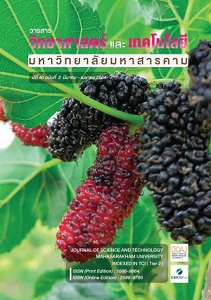- Study of fatigue behavior of AISI 1050 steel annealing with metal active gas process -
Main Article Content
Abstract
The propeller shaft of the fishing boat is made from AISI 1050 steel. It is often damaged by corrosion and breakage in use. Therefore, finding a suitable welding solution is the basis of this research objective. This study was carried out by studying the gas arc welding process with electric current at 130 Amperes and ER70S-6 welding wire with a welding speed of 250 millimeters per minute. The workpiece was pre-heated in an oven at 300 degrees Celsius for 30 minutes. After welding, the workpiece was annealed at 700, 800, and 900 degrees Celsius respectively. The results show that the suitable variables in this repair welding for fishing boat shaft was at 130 Amperes, welding speed at 250 millimeters per minute, and annealing temperature after welding at 900 degrees Celsius. It is also found that the heat from annealing after welding process results the average grain size at 22.43 micrometers and the grain size of heat-influenced welded area grew up as well around 254.41 micrometers respectively. Besides, it was found that the ferrite and pearlite phases were mixed together. Resulting in good toughness and strength properties. Moreover, it was found that 235,780 fatigue cycles were found to be pre-damaged.
Article Details
References
2. Damir Tomerlin. “Repair welding of a rotating electrical machine's broken shaft,” Welding and Cutting. Vol 18(3). pp. 198-203, 2019.
3. S. Sitthipong, P. Towatana, A. Sitticharoenchai, C. Meengam. “Abrasive Wear Behavior of Surface Hardfacing on Propeller Shafts AISI 4140Alloy Steel,” Materials Today: Proceedings. Vol 4. pp. 1492–1499, 2017.
4. Siva Sitthipong, Prawit Towatana, Amnuay Sitticharoenchai, Chaiyoot Meengam. “Fatigue Life Evaluation of Weld Surfacing LB 52 Grade,” Key Engineering Materials. Vol 744. pp. 259-263, 2017.
5. Prachya Peasura, Lersak Sumarn. “Effect of Post Weld Heat Treatment on Carbon Steel AISI 1050 in Heat Effected Zone,” Advanced Materials Research. Vol 650. pp. 612-615, 2013.
6. Structural welding code-steel. AWS D1.1 D1.1M:2010 (22nd Edition) An American National Standard, American Welding Society, 2010.
7. ASTM E606/E606M-12, Standard Test Method for Strain-Controlled Fatigue Testing, American Society for Testing and Materials, 2012.
8. P. Kumar, A. Singh. “Experimental and numerical investigation of strain rate effect on low cycle fatigue behaviour of AA 5754 alloy,” Materials Science and Engineering. Vol 364. pp. 1-7, 2014.
9. Fan, K. L., Liu, X. S., He, G. Q., Cheng, H., & Zhang, Z. “Influences of strain rate on the low cycle fatigue behavior of gravity casting Al alloys,” Materials Characterization. Vol 107. pp. 239-248, 2015.
10. Das, B., Bakkar, A., Khutia, N., Das, D. “Low Cycle Fatigue Performance Evaluation of TMT rebar,” Materials Today: Proceedings. Vol 4(2). pp 2554-2563, 2017.
11. Basquin, O.H. “The exponential law of endurance tests: American Society of Testing Materials,” ASTM, Vol 10. pp. 625-630, 1910.
12. Chun-Yuan Lin, Jui-Pin Hung, Tze-Chi Hsu. “Failure Analysis of Reverse Shaft in the Transmission System of All-Terrain Vehicles,” Journal of Failure Analysis and Prevention, Vol 8. pp. 75–80, 2008.
13. Silvain Michel, Rolf Kieselbach, Hans Martens. “Fatigue strength of carbon fibre composites up to the gigacycle regime (gigacycle-composites),” International Journal of Fatigue, Vol 28(3). pp. 261-270, 2006.
14. Tsuyoshi Shiozaki, Yoshikiyo Tamai, Toshiaki Urabe. “Effect of residual stresses on fatigue strength of high strength steel sheets with punched holes,” International Journal of Fatigue, Vol 80. pp. 324-331, 2015.
15. Hideaki Shibata, Keiro Tokaji, Takeshi Ogawa, Hirohisa Shiota. “Microstructure dependence of fatigue strength and fatigue crack propagation in titanium aluminide,” International Journal of Fatigue, Vol 18(2). pp. 119-125, 1996.
16. Kanji OKUDA, Kazuhiro OGAWA, Yuji ICHIKAWA. “Influence of microstructure on fatigue property of ultra high-strength steels,” Frattura ed Integrità Strutturale, Vol 48. pp. 125-134, 2019.
17. Zuopeng Zhao, Peng-Fei Xu, Hongxia Cheng, Jili Miao, Fu-Ren Xiao. “Characterization of Microstructures and Fatigue Properties for Dual-Phase Pipeline Steels by Gleeble Simulation of Heat-Affected Zone,” Materials, Vol 12(12), pp. 1-13, 2019.


